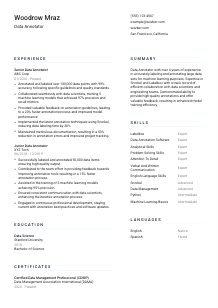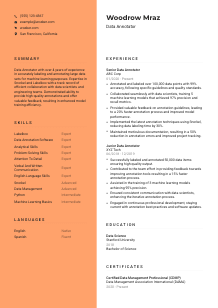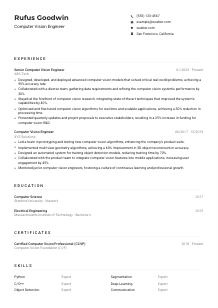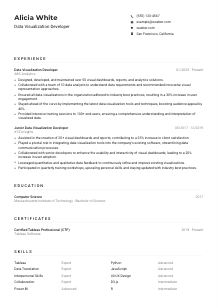Data Annotator Resume Example
Labeling and organizing datasets, but your resume feels unclassified? Untangle your career data with this Data Annotator resume example, created using Wozber free resume builder. Learn how to structure your annotation expertise to match job coordinates, positioning your profile as a high-quality datapoint in the vast sea of candidates.
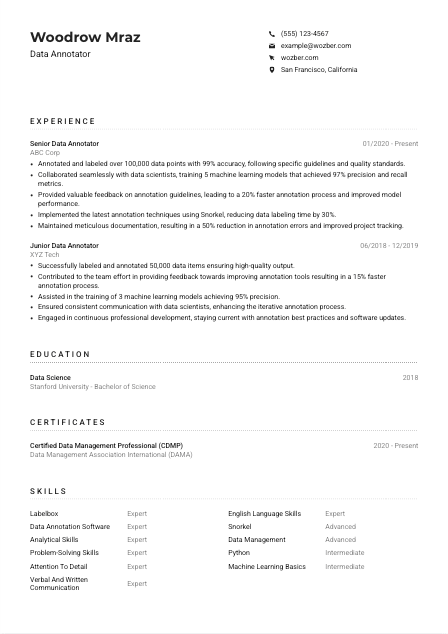
How to write a Data Annotator Resume?
Embarking on the journey to secure your next role as a Data Annotator? In the technologically advanced world of data science, your resume is not just a document, it's the key to unlocking your dream job. This guide, powered by the insights of Wozber, is your companion in crafting a resume that speaks directly to the essence of the Data Annotator position. With Wozber's free resume builder, ATS-compliant resume designs, and ATS resume scanner, you're about to create a resume that stands out in the digital age.
Ready to dive in and tailor your resume to highlight your annotation acumen? Let's get started!
Personal Details
First impressions matter, especially on your resume. The Personal Details section is your chance to immediately assure hiring managers that you're a contender worth considering. Here's how to fine-tune this section for your Data Annotator application.
1. Highlight Your Name
Your name is your brand. Make sure it's visible and memorable. A clear, readable font that's a tad larger than the rest showcases professionalism. Imagine your name as the title of your professional story.
2. Profession Alignment
"Data Annotator" - seeing this title right under your name aligns your identity with your career aspirations. This strategic placement signals to the hiring manager that you're not just applying; you're aiming for precision, much like in data annotation itself.
3. Essential Contact Details
A phone number without typos and a professional email address set the tone for reliable communication. Think firstname.lastname@email.com for an email setup that's both simple and professionally sound.
4. Localize Your Application
Positioning yourself as a local candidate eliminates potential hiring concerns. Stating "San Francisco, California" not only matches the job listing's locality requirement but also eases the logistics of your potential employment.
5. Web Presence
A LinkedIn profile or personal website is your playground for professional branding. Ensure it's updated and mirrors the narrative of your resume. This digital footprint can significantly bolster your application.
Takeaway
Consider the Personal Details section as your virtual handshake. It's succinct yet packed with the perfect amount of significant information, setting the stage for the richness that follows. Let this section reflect your professionalism and alignment with the Data Annotator role. First impressions last, so make it count!





Experience
The Experience section is where your resume really gets to shine. It's your opportunity to showcase how your past roles and accomplishments make you the ideal candidate for a Data Annotator position. Here's how to tailor this section to beautifully reflect your journey.
- Annotated and labeled over 100,000 data points with 99% accuracy, following specific guidelines and quality standards.
- Collaborated seamlessly with data scientists, training 5 machine learning models that achieved 97% precision and recall metrics.
- Provided valuable feedback on annotation guidelines, leading to a 20% faster annotation process and improved model performance.
- Implemented the latest annotation techniques using Snorkel, reducing data labeling time by 30%.
- Maintained meticulous documentation, resulting in a 50% reduction in annotation errors and improved project tracking.
- Successfully labeled and annotated 50,000 data items ensuring high‑quality output.
- Contributed to the team effort in providing feedback towards improving annotation tools resulting in a 15% faster annotation process.
- Assisted in the training of 3 machine learning models achieving 95% precision.
- Ensured consistent communication with data scientists, enhancing the iterative annotation process.
- Engaged in continuous professional development, staying current with annotation best practices and software updates.
1. Analyze Job Requirements
Start with the job description. For the Data Annotator role, experience in data annotation and proficiency in software like Labelbox or Snorkel is crucial. Highlight similar roles and tasks from your experience that respond directly to these demands.
2. Highlight Relevant Positions
Structure your professional history starting with the most recent role. Highlight your titles, the companies you've worked with, and the duration of each role. Use this section to show a trajectory that naturally leads to the role of a Data Annotator.
3. Detail Your Impact
For each role, dive into your contributions and accomplishments. Annotating over 100,000 data points or initiating a more efficient annotation process are achievements that speak volumes. Tailor each point to reflect your impact and prowess in data annotation.
4. Quantify Achievements
Numbers stand out. Whether it's the number of data points annotated or the percentage improvement in process efficiency, quantifiable achievements provide solid proof of your expertise and impact. It's a way to show, not just tell, your professional story.
5. Relevance is Key
Tailor your experience to the role. While it might be tempting to include every job you've had, focus on the ones that align most closely with data annotation. This keeps your resume focused and relevant, making it easier for hiring managers to see your fit.
Takeaway
Your Experience section is your professional narrative. It's where you demonstrate not just your suitability for the Data Annotator role, but also your excellence in it. Fine-tune your resume with Wozber's ATS-friendly resume format, ensuring each bullet point validates your candidacy. Let your achievements speak of your readiness to excel.
Education
In the realm of Data Annotation, your educational background lays the foundation of your technical knowledge. While the requirements may seem straightforward, presenting this section effectively can elevate your application.
1. Match Degree with Job Requirement
The job calls for a "Bachelor's degree in Computer Science, Data Science, or a related field." If your degree aligns, make it prominent. This direct match signals to hiring managers that you possess the foundational knowledge required for the role.
2. Structure it Right
List your degree, the field of study, and the institution, followed by the date of graduation. If you've multiple degrees, start with the most relevant to the Data Annotator role. This clarity helps the hiring manager quickly verify your educational qualifications.
3. Focus on Relevance
Especially for recent graduates or those transitioning into data annotation, highlighting specific courses or projects related to data science can be beneficial. However, the Bachelor of Science in Data Science stands robustly on its own, demonstrating your relevant knowledge base.
4. Supplementary Achievements
If you've been part of data science groups, completed impressive projects, or achieved high grades in relevant subjects, briefly mention these. They add value, especially if they showcase skills relevant to a Data Annotator's role.
5. Continuing Education
In a field as dynamic as data annotation, showing engagement with ongoing learning can be a plus. Mention any additional certifications, workshops, or courses you've taken that enrich your profile as a committed and evolving professional.
Takeaway
The Education section testifies to your technical competency and preparedness for the Data Annotator role. Beyond the degrees, it's a narrative of your learning journey relevant to data science. Ensure it's clear, relevant, and mirrors the requirements of your dream job. Your education is not just about completing courses; it's about paving your pathway to success.
Certificates
In the quickly evolving field of data science, certificates are like badges of honor; they showcase your dedication to refining your skills. Even though the job description for a Data Annotator might not explicitly demand them, well-chosen certifications can significantly bolster your application.
1. Handpick Relevant Certificates
Focus on certifications that highlight your expertise in data annotation, understanding of relevant software, or any related skills. For instance, being a "Certified Data Management Professional (CDMP)" speaks volumes about your commitment to mastering data management—a crucial aspect of data annotation.
2. Quality Over Quantity
It's tempting to list every certificate you've ever earned, but restraint is key. Select certifications that align closely with the requirements of a Data Annotator role. This ensures your resume remains focused and impactful.
3. Dates Matter
Including the date of certification, especially for recent achievements, can indicate your dedication to continuous learning. It also helps to signal how up-to-date your knowledge and skills are in the fast-paced field of data science.
4. Keep Evolving
The tech landscape changes rapidly, and so does the field of data annotation. Emphasize recent certificates, and always seek out opportunities to learn and certify in new skills or tools. This proactive approach demonstrates your adaptability and eagerness to stay at the forefront of industry trends.
Takeaway
Certificates in your resume are powerful indicators of your professional development and expertise specific to the Data Annotator position. Choose certifications that resonate with the role's demands and let them serve as proof of your constant evolution in the field of data science. With Wozber, you've got the tools to seamlessly incorporate these into your resume, ensuring ATS optimization for every application.
Skills
Your Skills section is essentially a highlight reel of your professional toolkit. It's crucial to align this part of your resume with the job description of a Data Annotator to catch the hiring manager's eye immediately.
1. Extract Required Skills
Start by carefully reading the job description and noting both explicit and implied skills required. For a Data Annotator, software proficiency, analytical abilities, and attention to detail are among the top required skills.
2. Direct Alignment
Grade your skills related to the job, like proficiency in "Labelbox" or "Data Annotation Software," as "Expert" to instantly communicate your competence. Highlight your analytical and problem-solving skills prominently as they're crucial to succeeding in the role.
3. Clarity and Focus
Resist the urge to list every skill you have. Instead, keep your list focused on those skills that are relevant to a Data Annotator. This selective showcasing ensures your resume is targeted and to the point, making it easier for the ATS and the hiring manager to see your fit for the job.
Takeaway
A well-curated Skills section speaks volumes about your professionalism and suitability for the Data Annotator role. With Wozber's ATS-friendly resume template, highlight the skills that make you an exceptional candidate for the position. Your professional toolkit is impressive—make sure it's impossible to overlook.
Languages
In the global field of data annotation, linguistic skills can set you apart. While the Data Annotator role may prioritize English, showcasing your multilingual abilities can highlight your ability to engage with diverse datasets and teams.
1. Core Language Requirement
Given the job description's emphasis on "English language skills essential," list English at the top, categorizing your proficiency as "Native." This meets a crucial job requirement head-on, convincing the hiring manager of your communication competence.
2. Additional Language Proficiency
Beyond the basic requirements, mentioning additional languages, like Spanish marked as "Fluent," showcases your versatility. In a role that may involve diverse data sets, this can be an unexpected plus, indicating your readiness to handle varied challenges.
3. Honesty in Proficiency
It's vital to accurately represent your language abilities. Overstating your proficiency can lead to expectations you may not meet, while understating could sell you short. Be honest and clear, using terms like "Native," "Fluent," "Intermediate," and "Basic."
4. Consider the Role's Global Scale
While the immediate job may not require additional languages, the global nature of data science work means your linguistic skills could become an asset. Reflect on the broader industry context when listing languages, considering future collaborations and projects.
5. Reflect on Language as a Tool
Each language you know is a tool for connecting with more data, more people, and more opportunities. View your linguistic capabilities as part of your professional toolkit, crucial for tasks that require understanding of cultural nuances or translation.
Takeaway
Linguistic skills on your resume highlight not just your ability to communicate, but also your potential to contribute to globally diverse projects. Presenting your languages clearly and truthfully reflects the richness of your personal background, adding depth to your professional persona. Let each language you know serve as a testament to your ability to thrive in the dynamic, interconnected world of data annotation.
Summary
The Summary is your elevator pitch, offering a snapshot of your professional journey and why you're the perfect fit for the Data Annotator position. Let's ensure this section grabs attention and marks you as an exceptional candidate.
1. Capture the Job's Essence
Begin with an overarching statement that captures your professional identity and directly addresses the Data Annotator role. Mention your years of experience and expertise, instantly showing alignment with the job at hand.
2. Highlight Pertinent Skills and Achievements
Lean into your skills in data annotation software and your analytical prowess. Highlight your achievements, like leading to enhanced model training or streamlining the annotation process, demonstrating your direct contribution to the field.
3. Brevity is Your Friend
Keep your summary concise, aiming for 3-5 compelling lines. This is about sparking interest, not detailing every accomplishment. Entice the hiring manager to read on, intrigued by your succinctly presented credentials.
4. Tailor it to Data Annotation
Your summary should resonate with someone looking for a skilled Data Annotator. Using specific terms and achievements related to data annotation will ensure your resume speaks directly to the needs and aspirations of hiring managers in this field.
Takeaway
The Summary is where you set the tone, offering a glimpse into what makes you not just a candidate, but the candidate for the Data Annotator role. With Wozber, refining your resume to include a powerful, ATS-optimized summary has never been easier. Let this section be the beacon that draws hiring managers in, compelled to learn more about your expertise and potential impact. Your professional journey in data annotation is unique—make it shine from the very start.
Launching Your Data Annotator Journey
Navigating the path to your next role as a Data Annotator requires a resume that not only meets but exceeds the expectations of hiring managers and ATS systems alike. With the insights and the power of Wozber's free resume builder, ATS-friendly resume templates, and ATS resume scanner at your disposal, you're equipped to create a resume that champions your expertise and sets you apart in the competitive field of data science. Remember, your resume is your narrative crafted with intentionality, precision, and a glimpse into your future contributions as a Data Annotator.
Let Wozber facilitate your journey towards crafting that perfect resume. Seize the opportunity to make your mark in the world of data annotation.

- Bachelor's degree in Computer Science, Data Science, or a related field.
- Minimum of 2 years of experience in data annotation or related data labeling roles.
- Proficiency in data annotation software, such as Labelbox or Snorkel.
- Strong analytical and problem-solving skills with a keen attention to detail.
- Excellent verbal and written communication skills.
- English language skills essential.
- Must be located in San Francisco, California.
- Annotate and label large volumes of data as per specified guidelines and quality standards.
- Collaborate with data scientists and machine learning engineers to ensure quality annotations for model training and evaluation.
- Provide feedback on annotation guidelines and tools to improve the overall annotation process.
- Stay updated with the latest annotation techniques and tools to ensure the use of best practices.
- Maintain documentation on annotation guidelines, methodologies, and project progress.





